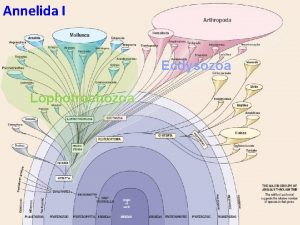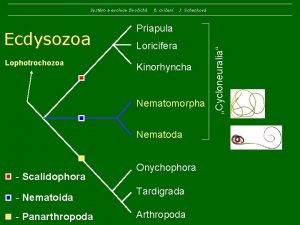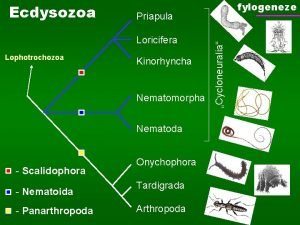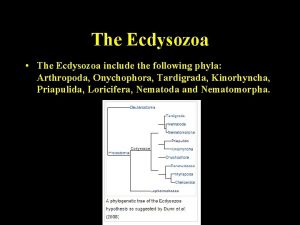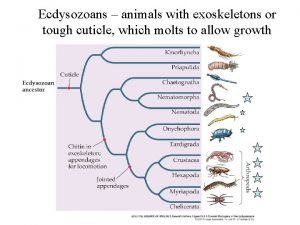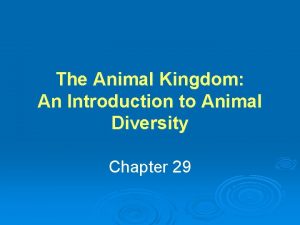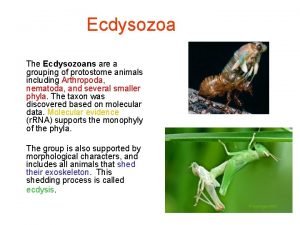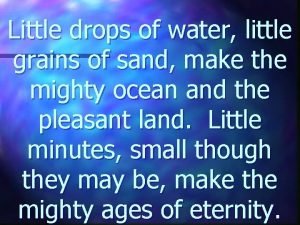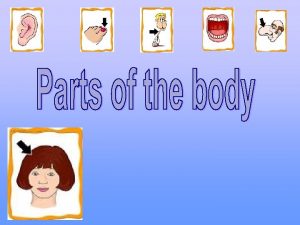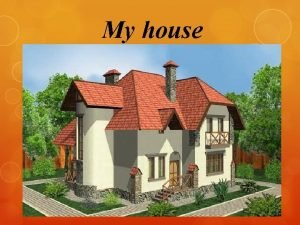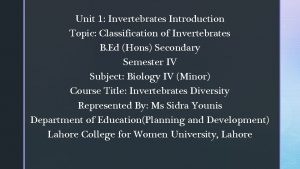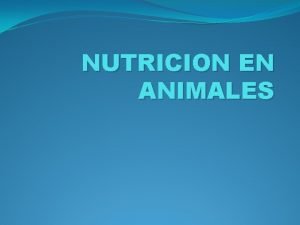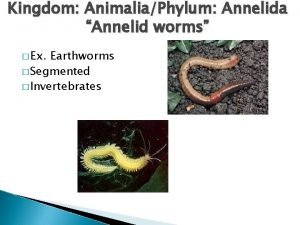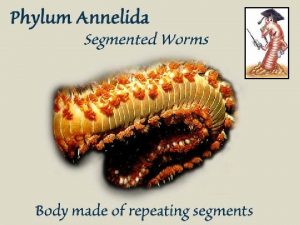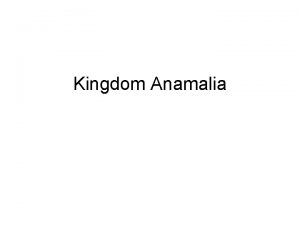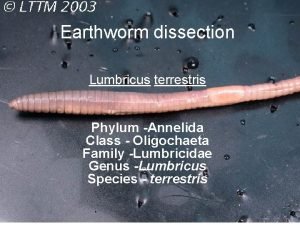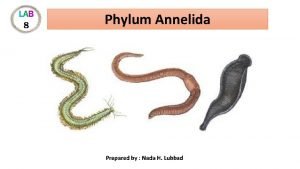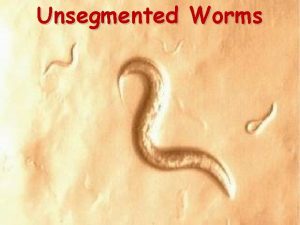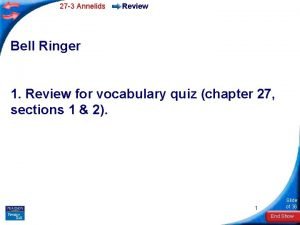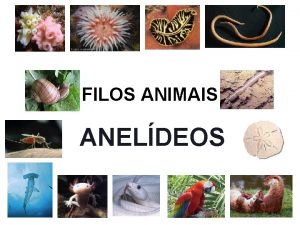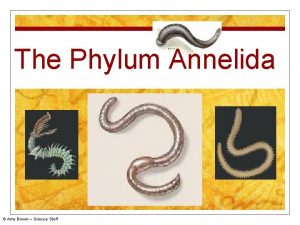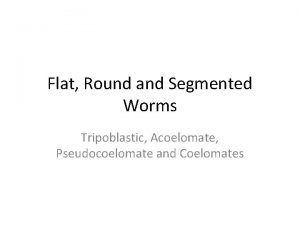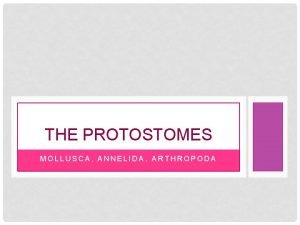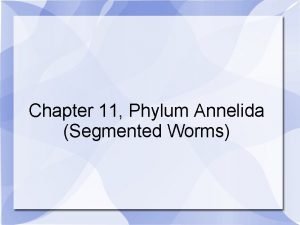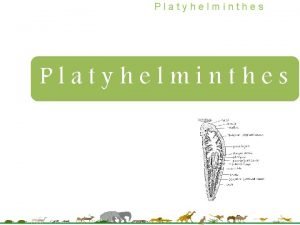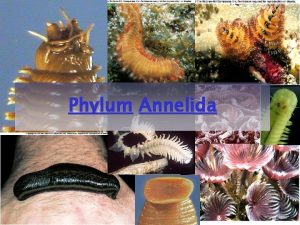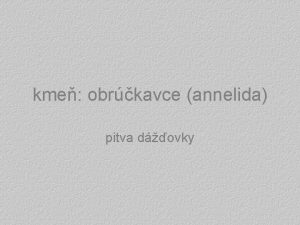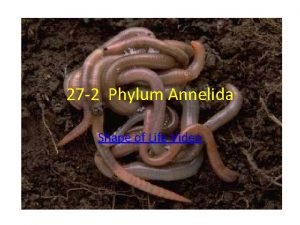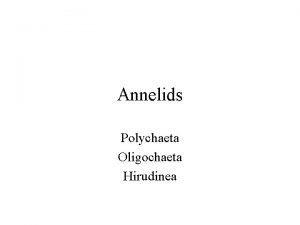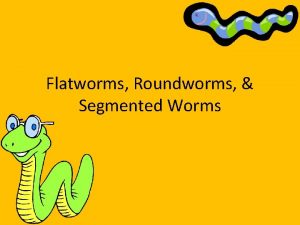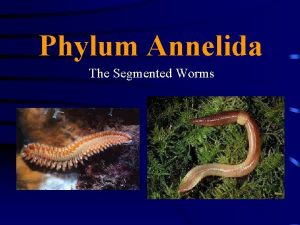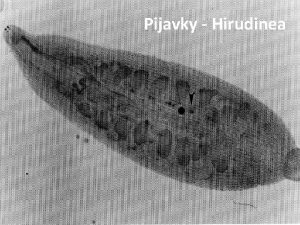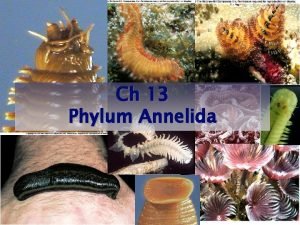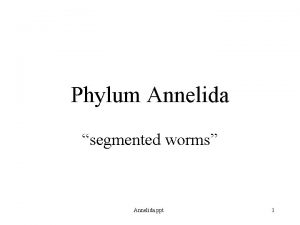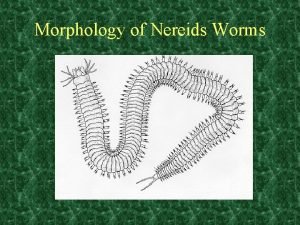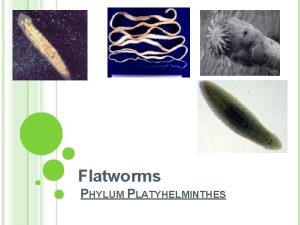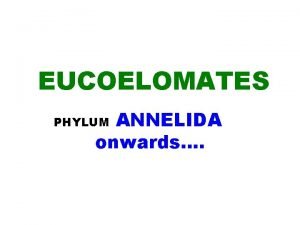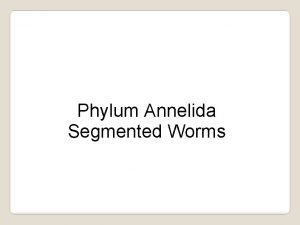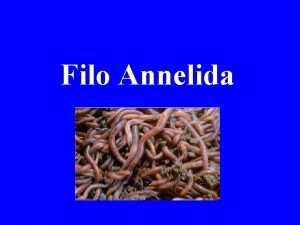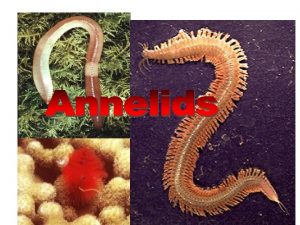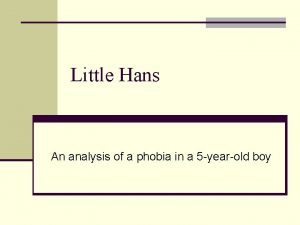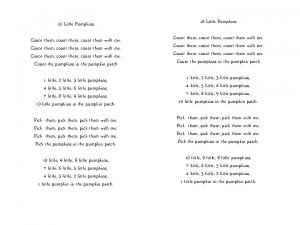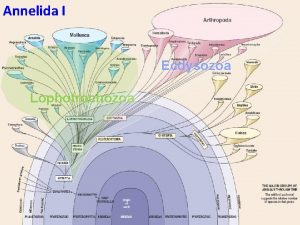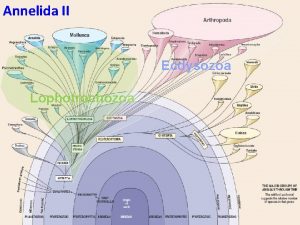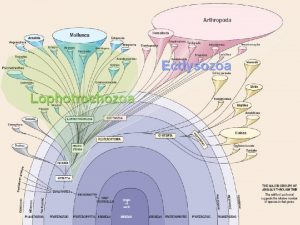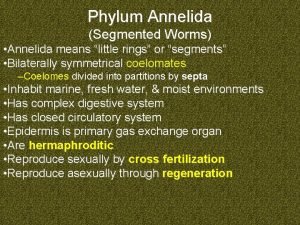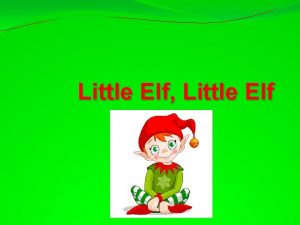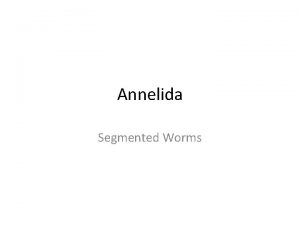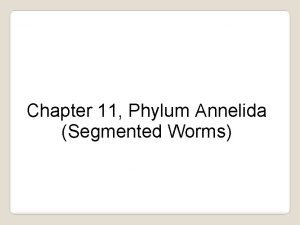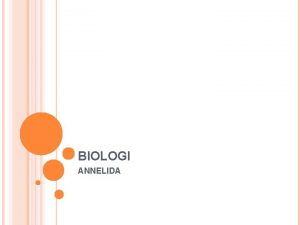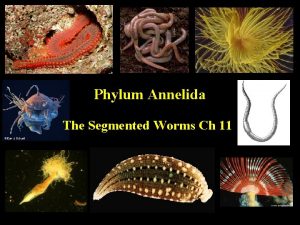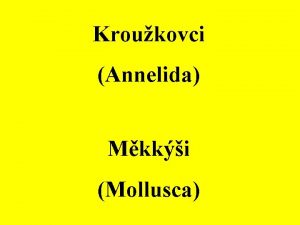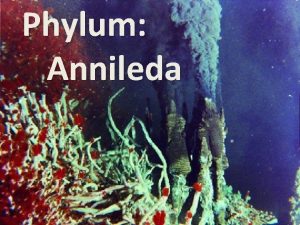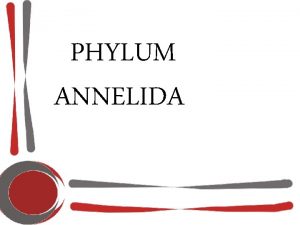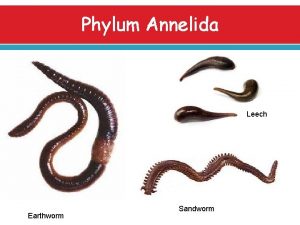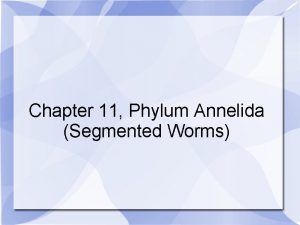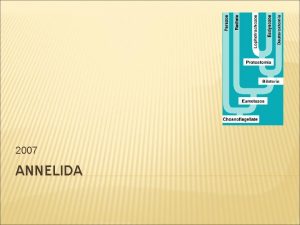Annelida I Ecdysozoa Lophotrochozoa 14 1 Annelida little

![Annelida [“little rings”] has gone under a great deal of systematic revision as more Annelida [“little rings”] has gone under a great deal of systematic revision as more](https://slidetodoc.com/presentation_image/b4551a29b4f8513b5a8111c3ecbbf9f1/image-2.jpg)










![Annelids display true segmentation [metamerism]. Implications: 1. Repetition of body organs 2. It forms Annelids display true segmentation [metamerism]. Implications: 1. Repetition of body organs 2. It forms](https://slidetodoc.com/presentation_image/b4551a29b4f8513b5a8111c3ecbbf9f1/image-13.jpg)















































- Slides: 60

Annelida I Ecdysozoa Lophotrochozoa 14 -1
![Annelida little rings has gone under a great deal of systematic revision as more Annelida [“little rings”] has gone under a great deal of systematic revision as more](https://slidetodoc.com/presentation_image/b4551a29b4f8513b5a8111c3ecbbf9f1/image-2.jpg)
Annelida [“little rings”] has gone under a great deal of systematic revision as more clades have been added. protostome schizocoelous coelomate spiral cleavage closed circulatory system respiration via skin/gills/parapodia complete digestive system

Phylum Annelida Phylogeny Over 22, 000 living annelid species, traditionally, annelids are divided among 3 classes – Class Polychaeta – Class Oligochaeta – Class Hirudinida

Of the > 17000 species, we will look at 3 different forms. Errantia: motile polychaetes Nereis virens Clitellata: fw oligochaetes and leeches Placobdella kwetlumye En. wikipedia. org Alitta virens En. wikipedia. org 4 RM Overstreet


Polychaeta is a paraphyletic class Oligochaeta and Hirudinida form a monophyletic group called Clitellata Characterized by reproductive structure called a clitellum


Errantia Sedentaria

Lineages can be distinguished by the number of setae, presence of a clitellum, presence of parapodia clitellum setae 9

Annelid Taxonomy “Polychaeta” – mostly marine; parapodia and many setae – includes Pogonophora/Vestimentifera • deep marine benthic tube dwellers; no guts(!) Clitellata – terrestrial/freshwater; no parapodia, few setae, possess a clitellum – includes “Oligochaeta” and Hirudinoidea • “Oligochaeta” = “earthworms” • Hirudinoidea = “leeches” and allies

Differentiation of classes based on setae, parapodia, larval type, number of segments, reproduction. 11 Polychaeta Oligochaeta Hirudinea setae many few absent parapodia present absent larval stage trochophore absent # segments ? to 3 m no annuli 31 -37, to 3 m no annuli 14 -34 annuli habitat marine aquatic and terrestrial freshwater reproduction dioecious monoecious clitellum absent present head distinct with not distinct sensory organs not distinct Notes: luminescent >250 yrs old oblique muscle suckers hyperdermic injection of sperm hirudin

Characteristics Annelids exhibit segmentation or metamerism – Bodies composed of serially repeated units – Each unit contains components of most organ systems Evolution of metamerism allowed much greater complexity in structure and function – Increased burrowing efficiency by permitting independent movement of segments – Evolution of a more sophisticated nervous system – Provided safety factor • If one segment failed, others could still function
![Annelids display true segmentation metamerism Implications 1 Repetition of body organs 2 It forms Annelids display true segmentation [metamerism]. Implications: 1. Repetition of body organs 2. It forms](https://slidetodoc.com/presentation_image/b4551a29b4f8513b5a8111c3ecbbf9f1/image-13.jpg)
Annelids display true segmentation [metamerism]. Implications: 1. Repetition of body organs 2. It forms a hydrostatic skeleton leading to control of fine movement Septa

Evidence of segmentation can be seen externally. leech annuli Head: prostomium and peristomium Pygidium: contains anus

Phylum Annelida Setae – Tiny chitinous bristles called setae – Absent in leeches – Short setae anchor segments in earthworms • Prevent it from slipping backward – Long setae help aquatic worms swim Polychaetes – Primarily marine and usually benthic Oligochaetes and leeches – Freshwaters, or terrestrial soils – Many leeches are predators

Phylum Annelida Body Plan Body Wall – Surface is covered with an epidermis and a thin outer layer of non-chitinous cuticle – Strong circular and longitudinal muscles underlie the body wall 17 -16

Phylum Annelida Hydrostatic Skeleton – Except in leeches, coelom is filled with fluid and serves as a hydrostatic skeleton – Fluid volume remains constant – Contraction of longitudinal muscles • Causes body to shorten and expand – Contraction of circular muscles • Causes body to narrow and lengthen – By separating this force into sections, widening and elongation move the whole animal – Alternate waves of contraction, or peristalsis, allow efficient burrowing – Swimming annelids use undulatory movements

Characteristics Share a trochophore as the ancestral larval form Segmented worms living in marine, freshwater, and moist terrestrial habitats Include marine bristle worms, leeches, and earthworms, pogonophorans, and vestimentiferan worms

This is the trochophore larva, and new segments are added anterior to the pygidium. The number of segments depends on the species, not the age. apical tuft prototroch Parasabella media, polychaete mouth anus Mc. Euen et al. 1983

Trochophore and Teloblastic Growth The segments develop one at a time from a growth zone just ahead of the pygidium, so that an annelid's youngest segment is just in front of the growth zone while the peristomium is the oldest. This pattern is called teloblastic growth.

Trochophore and Teloblastic Growth ectomesoderm Mesodermal band mesodermal blocks frontal view of trochophore



An annelid is a tube within a tube. www. deanza. fhda. edu

Polychaete The Polychaeta or polychaetes are a paraphyletic Generally marine. Has parapodia that bear many bristles, called chaetae, More than 10, 000 species. include the lugworm (Arenicola marina), clam worm Alitta.

Polychaete Basic Anatomy example: nereid polychaete homonomous segments – important segments: prostomium, peristomium and pygidium most segments bear parapodia (large flaps along sides of body)

A Nereid Polychaete gut blood vessels setae parapod coelom metanephridium longitudinal muscle nerve cord jaws pharynx

Polychaete Reproduction and Development some have epitokes (e. g. , Palolo worm) – swimming forms for gamete dispersal typical life cycle – zygote trochophore settlement adult teloblastic growth – growth from pygidial growth zone forward – mesoderm blocks split off and hollow out

The rear end of the Palolo worm, a marine polychaete that tunnels through coral, detaches in order to spawn at the surface the people of Samoa regard these spawning modules as a delicacy.

Class Polychaeta Diversity Largest class of annelids More than 10, 000 species, mostly marine Vary from 1 mm to 3 meters long More specialization of sensory organs than in clitellates Tolerate a wide range of salinity Warmer regions have more freshwater polychaetes Some live in crevices, others inhabit tubes, or are pelagic

Class Polychaeta Important part of marine food chains Well-differentiated head with sense organs Paired appendages called parapodia on most segments No clitellum Many setae arranged in bundles on parapodia Sedentary polychaetes mainly tube-living Errant polychaetes may be free-moving, burrowing, or crawling Clamworm Nereis is an example of a predatory polychaete with jaws on an eversible, muscular pharynx

Form and Function Prostomium may or may not be retractile – Often bears eyes, tentacles, and sensory palps – Surrounds mouth and may have setae, or chitinous jaws Ciliary feeders may bear a tentacular crown that opens like a fan but can be withdrawn into the tube Most segments of trunk bear parapodia with lobes, cirri, setae, and other parts – Aid crawling, swimming, and anchor worm in a tube – Usually the chief respiratory organ although the worm may also possess gills • Amphritite and Arenicola

Class Polychaeta Nutrition – Errant polychaetes are predators or scavengers – Sedentary polychaetes feed on suspended particles or particles in sediment

Class Polychaeta Circulation and Respiration – Most have gills for gaseous exchange • Others use the body surface – Circulation varies • In Nereis a dorsal vessel carries blood forward and a ventral vessel carries blood posteriorly • Blood flows across between these major vessels in networks around the parapodia and intestine – In some, septa are incomplete and coelomic fluid serves circulatory function – Many polychaetes have respiratory pigments • Hemoglobin, chlorocruorin or hemerythrin

Class Polychaeta Sense Organs – Sense organs include eyes, nuchal organs and statocysts • Eyes vary from simple eyespots to well-developed imageresolving eyes similar to mollusc eyes • Alciopid eyes specialized for wavelengths that penetrate deep seas • Nuchal organs are chemoreceptive • Some use statocysts to orient their body

Class Polychaeta Reproduction and Development – Polychaetes have no permanent sex organs – Monoecious – Gonads appear as simple temporary swellings of peritoneum – Gametes are shed into coelom and exit by gonoducts, metanephridia, or rupturing of the body – Fertilization is external and the early larva is a trochophore

Polychaete Diversity 1 benthic predators burrowers – small parapodia, tentacles; lots of hemoglobin pelagic predators – huge eyes, tentacles and parapodia tentacular suspension/detritus feeders – e. g. , “feather dusters” (sabellids, serpulids) • build calcareous, sand or proteinaceous tubes

Class Polychaeta Representative polychaetes Clam Worms: Nereis – Errant polychaetes – Live in mucus-lined burrows near low tide level – Come out of hiding places at night to search for food – Prostomium bears a pair of palps sensitive to touch and taste, a pair of short sensory tentacles, and two small dorsal eyes sensitive to light – Peristomium has a ventral mouth, a pair of jaws, and four pairs of sensory tentacles

Class Polychaeta Fireworms – Have hollow, brittle setae that contain poisonous secretions – Feed on cnidarians

a phyllodocid polychaete

nereid head w/everted pharynx

a sabellid polychaete (Eudistylia)

a terebellid

Ophiodromus (Hesionidae)

Class Polychaeta Tubeworms – Tube-dwellers – May line their burrows with mucus – Use cilia or mucus to obtain food Fanworms – Unfurl tentacular crowns to feed – Food moved from radioles to mouth by ciliary action Parchment Worms – Lives in a U-shaped tube – Modified segments pump water through tube


Polychaete Diversity 2 mucus suspension feeders (Chaetopterus), parchment – makes a U-shaped papery tube – holds a mucus net with two parapodia – pumps water through tube/net • particles are trapped on net; worms eats net commensals on mollusks, sea stars, etc. parasites – even parasitic on other polychaetes

Chaetopterus tubes

Chaetopterus

Pogonophora/Vestimentifera tentacles vestimentiferans opisthosoma

Pogonophora • external anatomy: tentacles (prosoma), forepart (mesosoma), trunk with papillae (metasoma), and opisthosoma – only opisthosoma is segmented no guts; some have a trophosome – bacterial symbionts generate ATP, reduce carbon dioxide to organic compounds

Hand, S. C. 1987. Trophosome ultrastructure and the characterization of isolated bacteriocytes from invertebratesulfur bacteria symbioses. Reference Biol Bull. 173: 260 - 276

Tevnia jerichoana. (a) In tube. (b) Removed from tube, showing four body regions.

Marine biologists preserving a specimen of Riftia sp. http: //www. nicholas. duke. edu/OSCexpedition/apr 11. html

The following characteristics are typical for members of Annelida: – A) segmentation, open circulation, and nephridia. – B) segmentation, closed circulation, and nephridia. – C) no anus, nephridia, and coelom. – D) anus derives from blastopore – E) mesoderm is enterocoely.

Phylum Annelida Coelom – Forms by schizocoely – Peritoneum (mesodermal epithelium) lines body wall and forms dorsal and ventral mesenteries – Peritonea of adjacent segments meet to form the septa – Gut and longitudinal blood vessels extend through the septa




Reconstruction of the Annelida phylogenetic tree. TH Struck et al. Nature 471, 95 -98 (2011) doi: 10. 1038/nature 098 64
 Annelid body plan
Annelid body plan Schenkov
Schenkov Nitkovci
Nitkovci Ecdysozoa
Ecdysozoa Cuticle in animals
Cuticle in animals Deuterostomia
Deuterostomia Ecdysozoa protostomes
Ecdysozoa protostomes Ten little indian boys poem
Ten little indian boys poem 1 little 2 little 3 little indian
1 little 2 little 3 little indian How much vs how many
How much vs how many Fill in a few a little
Fill in a few a little Little a little few a few
Little a little few a few Little grains of sand make the mighty ocean
Little grains of sand make the mighty ocean Complete the sentences. use enough with one of these words
Complete the sentences. use enough with one of these words Litle a
Litle a 2 feet go tap tap tap
2 feet go tap tap tap Mouse mouse where is your house
Mouse mouse where is your house Phylum annelida examples
Phylum annelida examples Proceso digestivo de los vertebrados
Proceso digestivo de los vertebrados Annelida
Annelida Feather duster worm anatomy
Feather duster worm anatomy Anamalia characteristics
Anamalia characteristics Peranan annelida
Peranan annelida Lumbricus dissection
Lumbricus dissection Annelida
Annelida Flatworm with unsegmented body
Flatworm with unsegmented body Restperation
Restperation Anelídeos simetria
Anelídeos simetria Parasitism phylum
Parasitism phylum Phylum
Phylum Nemertea
Nemertea Protostomia adalah
Protostomia adalah Segmented worms features
Segmented worms features Struktur trematoda
Struktur trematoda Phylum annelida
Phylum annelida Metanefrídie
Metanefrídie Shape of life annelids
Shape of life annelids Examples of oligochaeta
Examples of oligochaeta Platyhelminthes vs nematoda
Platyhelminthes vs nematoda Annelida
Annelida Habitat dos anelídeos
Habitat dos anelídeos Platyhelminthes adalah
Platyhelminthes adalah Subclass oligochaeta
Subclass oligochaeta Annelida
Annelida Morphology of annelida
Morphology of annelida Unsegmented, flat, bilateral symmetry, cephalization
Unsegmented, flat, bilateral symmetry, cephalization Nematódeos
Nematódeos Phylum annelida
Phylum annelida Metamerism is absent in
Metamerism is absent in Eucoelomate
Eucoelomate Anatomy of an earthworm
Anatomy of an earthworm Ppt annelida
Ppt annelida Annelida
Annelida My mother bore me
My mother bore me Little hans case study
Little hans case study Westborough little league
Westborough little league Pavlov dogs
Pavlov dogs Ciaran oliver
Ciaran oliver 10 little pumpkins
10 little pumpkins Little free library dimensions
Little free library dimensions Little dipper
Little dipper
